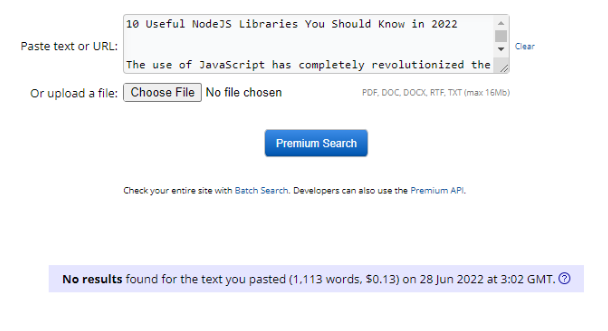Research
10 Useful NodeJS Libraries You Should Know in 2022

The use of JavaScript has completely revolutionized the web development ecosystem. Large-scale enterprises and even start-ups are preferring Node.JS, the open-source JavaScript runtime environment made on Google Chrome’s v8 engine, to develop enterprise-level applications. The reason that Node runs on numerous platforms like Windows, Linux, MacOS makes it the favourite-first tech for businesses.
The reason behind Node’s popularity cannot be attributed to just its features. Node also possesses extraordinary libraries that help developers develop apps or web applications smoothly and without any hassle. In simpler words, with Node.js’s extensive libraries, web app development is just a cakewalk. Let us go through the different Node.js libraries that are worth knowing in 2022.
Top 10 Node.JS Libraries
- Express.JS – Express.Js is one of the well-known and reputed Node.js libraries that is minimalist, flexible, and an opinionated web framework. It is available through the npm registry. You just need to follow certain steps to download and install it.
 The popularity of Express.js is unmatched. It records 13M downloads per week. It provides a robust set of functionalities to developers for developing mobile and web applications. The security updates are instantly updated in the open source library. The active community support has always your back in case you face any issue while working with Express.js.
The popularity of Express.js is unmatched. It records 13M downloads per week. It provides a robust set of functionalities to developers for developing mobile and web applications. The security updates are instantly updated in the open source library. The active community support has always your back in case you face any issue while working with Express.js. - Async.js – Async.js is another high-performing Node.js library that lets developers work with asynchronous JavaScript. It helps improve the performance of web pages by eliminating the render-blocking symptom of JavaScript. You can download and install Async by following the npm command:
 Async can also be downloaded in the browser. It provides almost 70 functions including the usual ‘functional’ elements that includes (map, reduce, filter, each…) and other patterns for asynchronous control flow (parallel, series, waterfall…).
Async can also be downloaded in the browser. It provides almost 70 functions including the usual ‘functional’ elements that includes (map, reduce, filter, each…) and other patterns for asynchronous control flow (parallel, series, waterfall…). - Gulp – You can easily automate the painful tasks using this wonderful plugin, Gulp. This plugin also enhances the development workflow by providing extensive support and flexibility. You can install Gulp by following the command:
 Gulp helps in automating the slow and repetitive tasks like concatenating library files, compiling the SASS files, minification of HTML and CSS, and building pipelines for easy flow of work. It uses JavaScript code and Node.js as a platform to run various tasks.
Gulp helps in automating the slow and repetitive tasks like concatenating library files, compiling the SASS files, minification of HTML and CSS, and building pipelines for easy flow of work. It uses JavaScript code and Node.js as a platform to run various tasks. - Browserify – Some JavaScript libraries create challenges for developers and it becomes quite difficult to manage them. Here comes this node.js library, Browserify, that helps developers test the templates and go through the scripts running on JavaScript library and widgets.
With Browserify, you can build client-side codebases and organize them in a systematic approach. You can even use a third-party library if using Node is not possible only to the extent of bundling and installing packages with npm. Module system for both Node and Browserify is the same, hence the packages under npm work fine for both individually. - PM2 – PM2 is a simple, straightforward, and intuitive CLI that helps you manage your application and keep it online. It is easily installable through npm command:
$ npm install pm2@latest -g
# or
$ yarn global add pm2
Once you have installed and started the application, you will be able to check the stats, logs, metrics in an online dashboard. It also helps you in process management during the development phase. You can also tweak any feature or functionality and manage the production process easily with PM2.
- Request – In general, some apps need to access content from sources outside the defined library. In such cases, the Request library helps applications to make HTTP calls in a safe and dependable way to access such external content. HTTP requests have become necessary for apps to run in a smooth way and the Request library runs it in easy-to-use and straightforward manner.
With a Request Library in hand, one need not look for external sources for data.
Request.js can also integrate authentication methods as it is an ideal app for such purposes.
- Bower.io – Bower.io is considered to be a great package manager as it saves you from managing and handling the array of tools, frameworks, libraries that you use while the web app development. Components containing HTML, JavaScript, CSS, image files, fonts, etc are managed by Bower.io. Bower can be installed by the following command:
npm install -g bower
There may be a misconception that Bower does all these things by minifying codes or compromising them. That is not the case.Bower just installs the right set of versions of the packages and their dependencies to manage these components. Moreover, Bower keeps a check on Node.js packages, risks, and updates the components regularly, thereby enhancing security of your web app.
- Nodemailer – Used by the majority of Node.js users, Nodemailer is a module that helps users to send emails seamlessly. Back in 2010, when there were not adequate methods to send email through node.js web apps, Nodemailer was invented to make things simple. It can be installed by:
npm install nodemailer
It is a single module with no dependencies. The codes are easily auditable and support unicode fonts and emojis. It uses both HTML as well as plain texts and can be easily run on Windows. You can attach or embed anything just like in Gmail.
- Axios – The axios library is another celebrated library in the Node.js community. It is a promise-based HTTP Client for Node.js and browsers. It offers an easy-to-use and simplified library in a minimized package with extensible interfaces. It can be installed by:
$ npm install axios
It runs on almost all browsers including Google Chrome, Mozilla Firefox, Internet Explorer, and others. It makes XMLHttpsRequests from the browser to interact with servers. It also intercepts the requests, transforms JSON data, and even cancels the requests.
- JSHint – Committing errors while coding huge structures is inevitable. In cases where developers need to maintain huge codebases and also keep them error-free, JSHint comes into the picture. It is a tool managed by the JS community that helps detect errors and problems in the JavaScript code. It was introduced with an objective to let developers write huge codebases without worrying about typos and language errors.
Wrapping Up
This was the comprehensive list of top 10 useful Node.js libraries you should know as a developer in 2022. These libraries make the process of web development a lot easier. Even businesses are looking to hire node js developer who have extensive knowledge of these libraries and who can integrate these libraries in their project. Hope this has given you an idea of the libraries. Happy Coding!
Copyscape report:
Author Name:- Harikrishna Kundariya
Biography:- Harikrishna Kundariya, a marketer, developer,
IoT, ChatBot & amp; Blockchain savvy, designer, co-founder,
Director of eSparkBiz Technologies, A Software
Development Company. His 10+ experience enables him to
provide digital solutions to new start-ups based on IoT and
ChatBot.





1 Comment